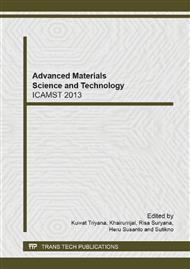p.149
p.153
p.159
p.163
p.168
p.175
p.179
p.183
p.187
Corrosion of Carbon Steel in Nanofluid Containing ZrO2 Nanoparticle at Different Temperature
Abstract:
Corrosion of carbon steel in nanofluid containing 0.1 gpl of ZrO2 nanoparticle at temperature from 25 to 55°C was investigated by using potentiodynamic polarization techniques. The open circuit potential measurements, cathodic and anodic polarization were used to characterize the corrosion behavior of carbon steel. Metallurgical techniques such as optical microscopy and X-ray diffraction (XRD) were used to characterize the alloys before and after corrosion testing. The microstructures of the as received carbon steel exhibited equaxed morphology. While corrosion specimens showed that microstructure of carbon steel alloys relatively unchanged after polarization testing. X ray diffraction examination of carbon steel before polarization represent γ phase and after polarization is still γ phase with minor Fe2O3. The open circuit potentials of carbon steel increase to positive displacement with increasing temperature nanofluids. The results of polarization technique show that corrosion currents increase and therefore corrosion rates become faster with the increase of nanofluids temperature.
Info:
Periodical:
Pages:
168-172
Citation:
Online since:
February 2014
Authors:
Keywords:
Price:
Сopyright:
© 2014 Trans Tech Publications Ltd. All Rights Reserved
Share:
Citation:


